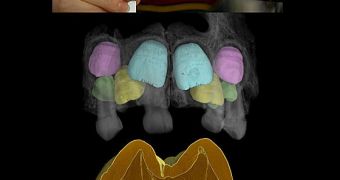A new research carried out by scientists at Harvard University, the Max Planck Institute for Evolutionary Biology (MPI-EVA), and the European Synchrotron Radiation Facility (ESRF), on teeth coming from 11 Neanderthal and early human fossils, revealed that modern humans reach full maturity much slower than our ancestors did.
This very sophisticated new analysis suggests that modern humans' slow development and long childhood are quite recent features, and also specific to our own species.
This change in development might also have given early humans an evolutionary advantage over Neanderthals.
[ADMARK=1Tanya M. Smith, assistant professor of human evolutionary biology at Harvard, and her colleagues analyzed the teeth and found that young Neanderthals' teeth growth was much faster than it was for our species, even for some of the earliest modern humans that left Africa between 90,000 and 100,000 years ago.
This new study included one of the most famous Neanderthal children and the first hominin fossil ever discovered, back in the winter of 1829-1830, in Belgium.
After comparing with modern humans, the researchers first believed to have been four or five years old at the time of death, but today, synchrotron X-rays and biological rhythms inside teeth revealed that the child was actually only three years old.
Smith admits that counting lines in teeth is not a new method, but adds that doing it 'virtually' with the synchrotron micro-computed tomography is.
She explains that “teeth are remarkable time recorders, capturing each day of growth much like rings in trees reveal yearly progress.
“Even more impressive is the fact that our first molars contain a tiny 'birth certificate' and finding this birth line allows scientists to calculate exactly how old a juvenile was when it died.”
The sequencing of the Neanderthal genome already proved that between modern humans and Neanderthals there were differences in cranial and skeletal development, and this new discovery adds up to the research.
Unlike early humans, other primates have shorter gestation, faster childhood maturation, the ability to reproduce at a younger age but also a shorter lifespan, and the reason for which this happened in the past 6 to 7 million years is rather unclear.
“These new methods present a unique opportunity to assess the origins of a fundamentally human condition: the costly yet advantageous shift from a primitive 'live fast and die young' strategy to the 'live slow and grow old' strategy that has helped to make humans one of the most successful organisms on the planet,” says Smith.
The fact that modern humans matured later than Neanderthals did, helped them learn new things and might have been the advantage they had over their cousins.
This research was led by scientists at Harvard University, the Max Planck Institute for Evolutionary Biology (MPI-EVA), and the European Synchrotron Radiation Facility (ESRF), and it is published in the Proceedings of the National Academy of Sciences.

 14 DAY TRIAL //
14 DAY TRIAL //